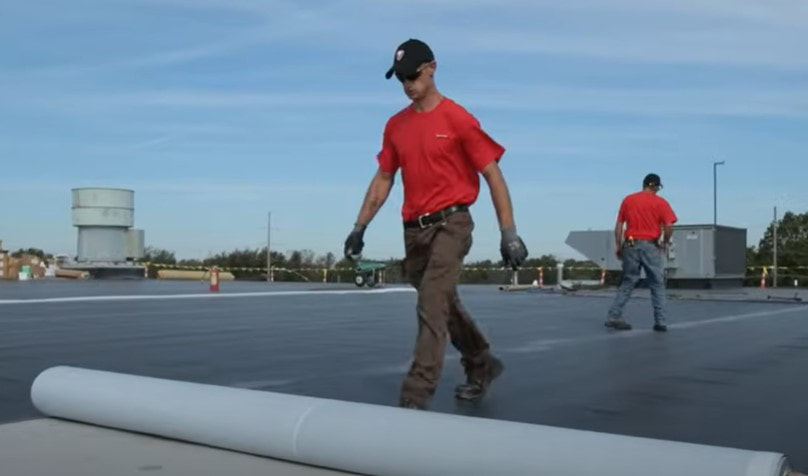Rolled Roofing Service In DetroitMotor City Roofers is a roofing company located in Detroit, MI. We offer a variety of services including roll roof installation and repair. In this article we will be discussing the various aspects of rolled roofing, its installation process, and the benefits that it offers its service providers.
What are Rolled Roofs? A rolled roof is a self-adhesive membrane that is installed on an already existing roof. The membrane is then covered with an asphalt or felt layer to protect the membrane from cracking. This offers an aesthetically pleasing alternative to wrap roofs or tar paper roofs for those who live in less harsh climates as it can last up to 40 years if properly maintained. |
|
Installation Rolled Roof Process
The installation process of rolled roofing requires the use of a machine called an inversion roller. This machine is used to turn the roofing membrane inside out, facilitating its installation. The machine also gives the roofing material a superior level of adhesion and makes certain that it takes the right shape and form. After being installed, the rolled roofing is then coated with an asphalt cement coating or thick felt material to further secure it from elements such as heat, cold, water, salt and asphalt shingles. However these coatings are not always required when installing rolled roofing on existing surfaces that have previously been covered in tar paper or other top layers.
10 Benefits of the Rolled Roof
1.The rolled roofing material is extremely thin, making it easier to install compared to other top materials.
2.The rolled roofing is less likely to become heavy and sag when installed correctly.
3.It is a permanent solution for many roofs due to its long lifespan.
4.The fact that it can be installed on existing roofs makes it more appealing than other types of materials such as asphalt shingles .
5.It is aesthetically pleasing and goes well with most architectural styles.
Types of rolled roofing
There are 3 types of rolled roofing:
1.asphalt rubber roofing
2.PVC roofing
3.EPDM roofing.
How to install rolled roofing
Rolled roofing can be installed on existing buildings or houses. You first need to remove the existing roofing material and then install the new material. It is best reinstall the rolled membranes over existing solid substrates such as concrete, spaced wood or plywood, or other materials.
Rolled Roofing Durability/Lifespan
There are two factors that affect rolled roofing durability and lifespan:
1) type of substrate where the membrane is installed onto
2) how it is maintained.
The type of substrate affects a user's decision regarding which form of rolled roof system to install because it makes a difference in how long it will last and how well it performs. Common substrates for rolled roof systems include:
The type of substrate you choose for your roof depends on its size, the frequency of use and condition.
Rolled Roofs provide a safe and solid solution to most roofs that are exposed to harsh elements like UV radiation from the sun and high winds caused by storms. Their durability and long lifespan ensure that you will have your roof for a very long time!
For more information about Roll Roof Installation, please contact Motor City Roofers today.
The installation process of rolled roofing requires the use of a machine called an inversion roller. This machine is used to turn the roofing membrane inside out, facilitating its installation. The machine also gives the roofing material a superior level of adhesion and makes certain that it takes the right shape and form. After being installed, the rolled roofing is then coated with an asphalt cement coating or thick felt material to further secure it from elements such as heat, cold, water, salt and asphalt shingles. However these coatings are not always required when installing rolled roofing on existing surfaces that have previously been covered in tar paper or other top layers.
10 Benefits of the Rolled Roof
1.The rolled roofing material is extremely thin, making it easier to install compared to other top materials.
2.The rolled roofing is less likely to become heavy and sag when installed correctly.
3.It is a permanent solution for many roofs due to its long lifespan.
4.The fact that it can be installed on existing roofs makes it more appealing than other types of materials such as asphalt shingles .
5.It is aesthetically pleasing and goes well with most architectural styles.
Types of rolled roofing
There are 3 types of rolled roofing:
1.asphalt rubber roofing
2.PVC roofing
3.EPDM roofing.
How to install rolled roofing
Rolled roofing can be installed on existing buildings or houses. You first need to remove the existing roofing material and then install the new material. It is best reinstall the rolled membranes over existing solid substrates such as concrete, spaced wood or plywood, or other materials.
Rolled Roofing Durability/Lifespan
There are two factors that affect rolled roofing durability and lifespan:
1) type of substrate where the membrane is installed onto
2) how it is maintained.
The type of substrate affects a user's decision regarding which form of rolled roof system to install because it makes a difference in how long it will last and how well it performs. Common substrates for rolled roof systems include:
The type of substrate you choose for your roof depends on its size, the frequency of use and condition.
Rolled Roofs provide a safe and solid solution to most roofs that are exposed to harsh elements like UV radiation from the sun and high winds caused by storms. Their durability and long lifespan ensure that you will have your roof for a very long time!
For more information about Roll Roof Installation, please contact Motor City Roofers today.

